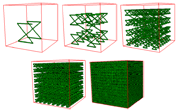We achieve real time exploration of large regular grids via a novel hierarchical
z-order data layout combined with progressive computation of
output slices or volume rendering.

We use the 3D z-order space filling curves to define a hierarchical subsampling
of a regular grid.

Simple bit manipulations allow to compute the address of a data sample in hierarchical
z-order from the original (i,j,k) row major array index. This allows to combine the coarse-to-fine progressive traversal with fast direct data access.

Practical performance tests show order of magnitude improvement with respect to previous storage layouts and scalability with respect to both data size and computing resources available.























